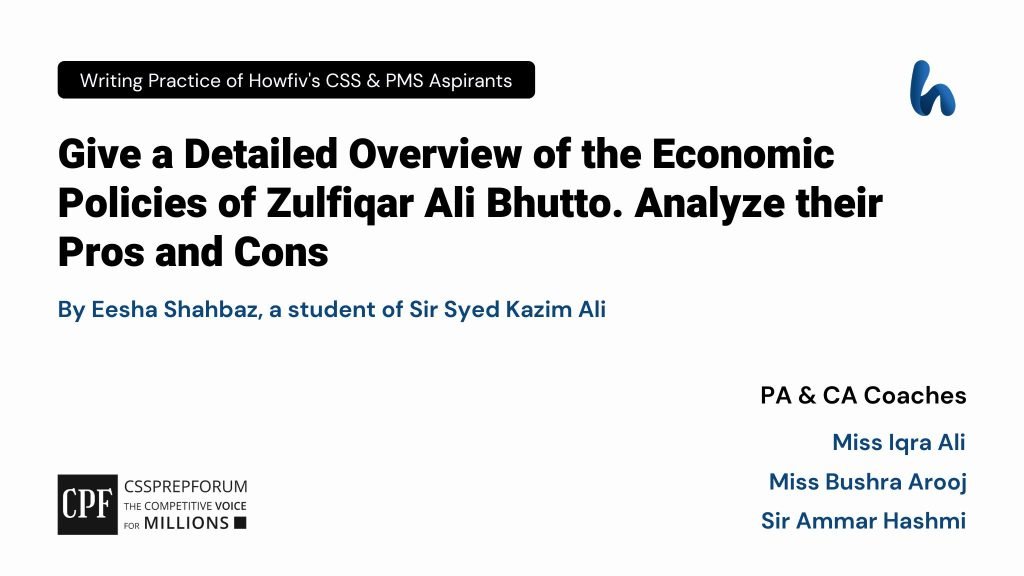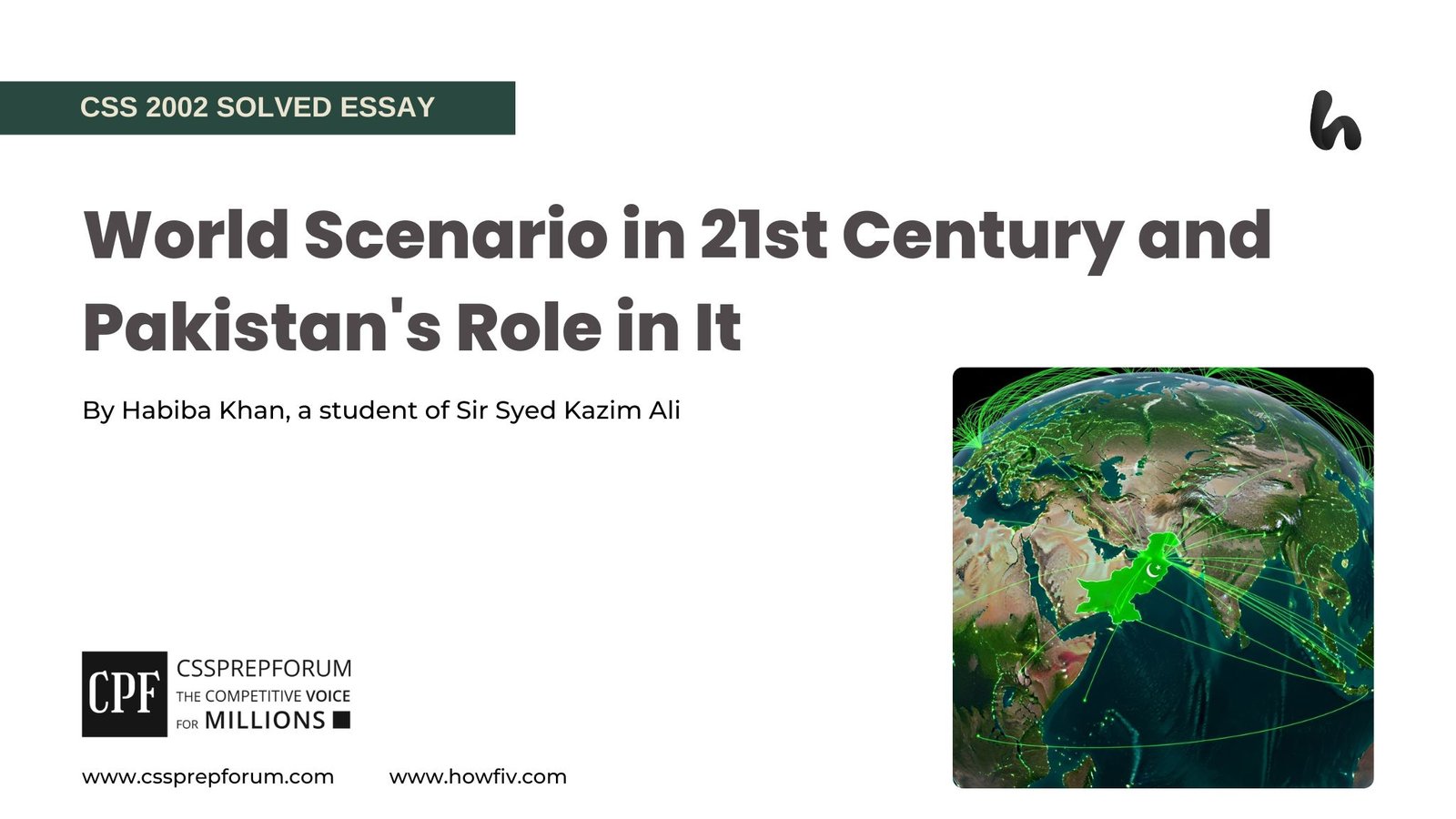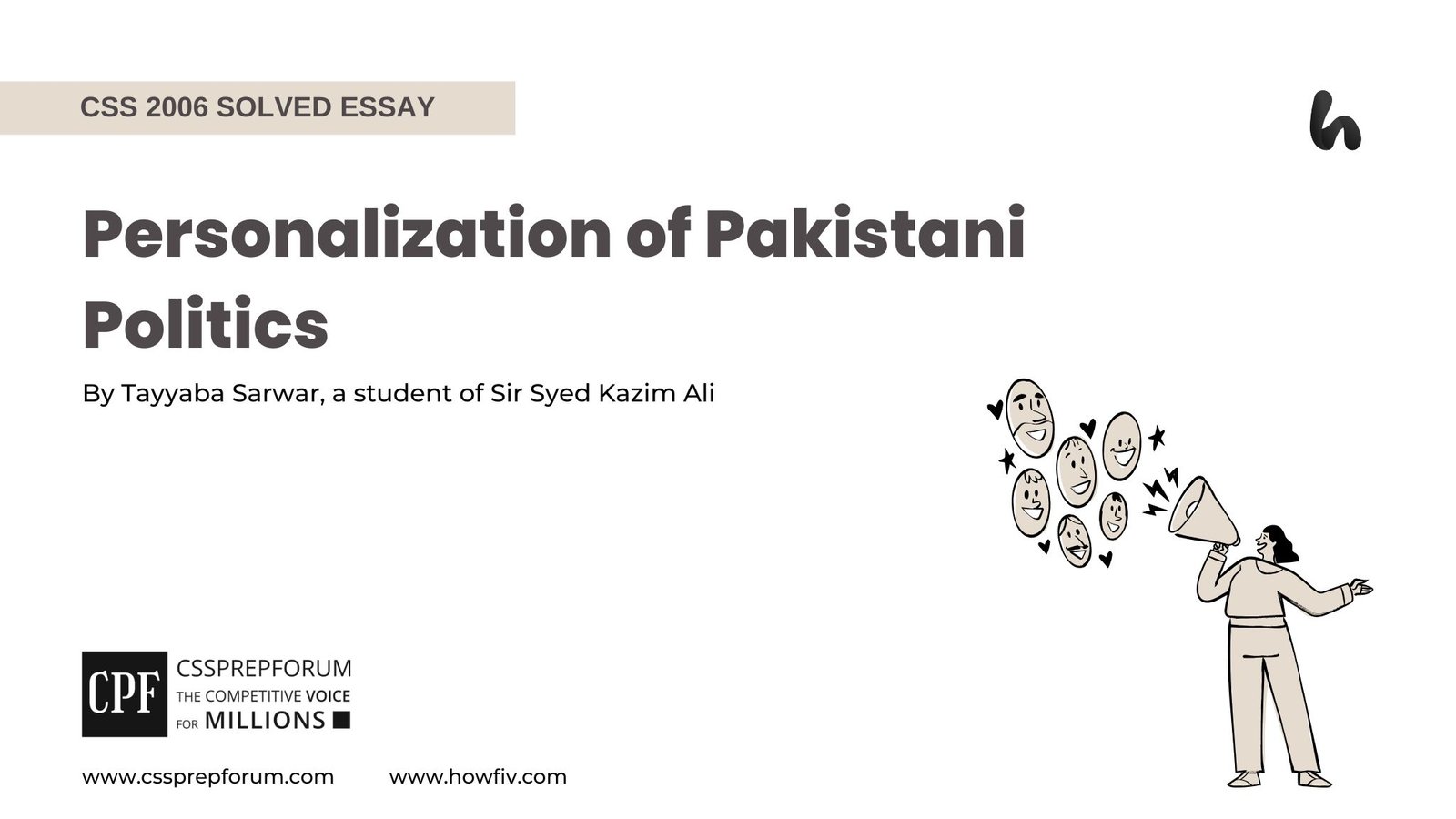CSS Pakistan Affairs | The Economic Policies of Zulfiqar Ali Bhutto
The following question of CSS Current Affairs is solved by Eesha Shahbaz under the supervision of Howfiv’s Pakistan Affairs and Current Affairs Coaches. She learnt how to attempt 20 marks question and essay writing from Sir Syed Kazim Ali, Pakistan’s best CSS and PMS English essay and precis teacher with the highest success rate of his students. This solved past paper question is attempted on the pattern taught by Sir to his students, scoring the highest marks in compulsory and optional subjects for years, and uploaded to help aspirants understand how to crack a topic or question, how to write relevantly, what coherence is, and how to include and connect ideas, opinions, and suggestions to score the maximum.

Outline
1-Introduction
2-An overview of the condition of Pakistan’s economy at Zulfikar Ali Bhutto’s time
3-Economic Policies implemented by Zulfikar Ali Bhutto
3.1. Nationalization Policy
- ✓ Nationalization of key industries like banks, insurance, and heavy industries
- ✓ Establishment of the State Life Insurance Corporation
- ✓ Focus on reducing financial monopolies and creating a mixed economy
3.2. Agricultural Reforms
- ✓ Limitations on land ownership (canal and rainy land)
- ✓ Redistribution of unclaimed land to farmers
- ✓ Provision of land to government officials and gradual reduction in ownership limits
3.3. Labor Reforms
- ✓ Introduction of minimum wages and bonuses for labourers
- ✓ Social security measures for workers
- ✓ Provision of residential quarters for labourers
3.4. Education and Health Sector Development
- ✓ Establishment of medical colleges and formal prescription procedures
- ✓ Nationalization of schools and colleges
- ✓ Creation of the National Book Foundation and support for higher education institutions
4-Pros and Cons of Zulfikar Ali Bhutto‘s Economic Policies
4.1. Pros of Zulfikar Ali Bhutto‘s Economic Policies
- ✓ Promotion of Social Welfare by focusing on health and education
- ✓ Improved access to services for all social classes
- ✓ Reduction of Income Disparity by Redistribution of land addressing rural wealth inequality
4.2. Cons of Zulfikar Ali Bhutto’s Economic Policies
- ✓ Discouragement of private enterprise leading to economic stagnation due to Nationalization
- ✓ Inefficiency in nationalized sectors and lack of incentives for business
- ✓ Currency devaluation impacting prices and exports
5-Critical Analysis
6-Conclusion

Answer to the Question
Introduction
A stable economy is the base upon which a country’s sovereignty, political might, and global standing stand still. It determines a country’s saying in the geopolitical arena and strengthens its position not only in the region but also globally. However, countries with dwindling economies fall prey to multiple challenges, dancing to the tunes of foreign donors. Unfortunately, Pakistan’s economy is no exception to this. The country’s history has been plagued with multiple military coups and failed economic policies that have shaped the present sorry state of the country. Throughout history, successive governments have devised their own policies that have thrust Pakistan’s economy into a vicious loop of challenges with some gains. When Zulfikar Ali Bhutto came to power, the country’s economy was teetering on the brink of collapse. Being inclined more towards socialism, Zulfikar Ali Bhutto introduced multiple reforms in agricultural, education, healthcare, and labour reforms followed by nationalization policies. While his policies brought fruitful results, a plethora of challenges followed, leaving Zulfikar Ali Bhutto’s economic policies at a critical juncture. His economic reforms were successful in improving access to all social classes, reducing income disparities, and addressing rural wealth inequalities. On the darker side, discouraging private enterprises due to nationalization led to economic stagnation. Moreover, inefficient nationalization sectors, lack of business incentives, and currency devaluation derailed the country’s economic progress. Thus, this answer sheds light on Zulfikar Ali Bhutto’s economic policies, followed by the pros and cons.
An overview of the condition of Pakistan’s economy at Zulfikar Ali Bhutto’s time
Throughout Pakistan’s history, the late 1960s have been considered to be the most challenging economic episode. It was the time when the Gross domestic product (GDP) per capita went to a negative trend, which led the economy to suffer to a great extent. The country’s condition was highly unfavored any new economic system; however, Zulfikar Ali Bhutto came up with his own idea of economic policies that were highly inclined towards Socialism. During his campaigns, he emphasized giving basic rights to the poor people, reflecting his political agenda, ‘Roti, Kapra, Makan (food, cloth, shelter).’ This slogan illustrated his belief in confronting the existing social injustices, unequal distribution of wealth, and many other factors. Moreover, economic growth mainly benefited the elite and industrialists, widening the wealth gap. Lastly, the economic policies favoured West Pakistan, causing frustration in East Pakistan (now Bangladesh.
Economic Policies Implemented by Zulfikar Ali Bhutto
Following are the key economic policies implemented by Zulfikar Ali Bhutto during his tenure as the President of Pakistan.
- Nationalization Policy
The nationalization polices, which got famous, include the following key points.
A- Nationalization of key industries like banks, insurance, and heavy industries
One of the most crucial steps taken by Zulfikar Ali Bhutto was the nationalization of key industries like banks, insurance, and heavy industries. Industries like steel mills were nationalized and placed under the charge of government. Banks and insurance companies that had heretofore been practicing on a private level; were also nationalized under the auspices of Bhutto’s nationalization venture of the time. This initiative was taken to decrease dependence on foreign imports. Nationalized industries were expected to provide employment and contribute to economic growth.
B-Establishment of the State Life Insurance Corporation
State Life Insurance Corporation was established to improve the economy of the country. This aimed to provide greater state control over finance and ensure that insurance services were given to all citizens regardless of the social divide. This helped industries and the general masses for better risk management. While it received great criticism, it was an effort aimed at improving the efficiency of state-run insurance companies.
C-Focus on reducing financial monopolies and creating a mixed economy
Zulfikar Ali Bhutto introduced policies aimed at reducing financial monopolies and establishing a mixed economy by promoting state-owned enterprises. While he focused on nationalizing the key sectors, he also recognized the role of the private sector. He introduced the Economic Reforms Order of 1972 to limit ownership stakes in multiple companies, developing competition. Further, he included policies supporting private investment in agriculture and the creation of planning institutions that integrated both public and
- Agricultural Reforms
A-Limitations on land ownership (canal and rainy land)
Just like the industrial sector, the agriculture sector also went through some significant changes under Zulfikar Ali Bhutto’s economic policies. The government devised policies that limited land ownership. The limit to own canal land was fixed between 150 and 100 acres, while 300 to 1000 acres of rainy land was allowed to be owned by the central government’s order.
B-Redistribution of unclaimed land to farmers
Another significant step taken by the government of that time was the redistribution of unclaimed land to farmers and cultivators. However, the part of the land lying close to defence lines was seized by the government. This initiative helped the government enable farmers to cultivate crops and improve their livelihoods. Moreover, this reduced the power concentration of wealthy owners and enhanced agricultural productivity and food security. This was done to uplift the rural economy and ensure its benefits were shared equally among society.
C-Provision of land to government officials and gradual reduction in ownership limits
The government also announced the allocation of 100 acres of land for the retirement of high-ranking government officials. The land given to farmers and cultivators by the government was transferred in their names, and they held the legitimate right to retain or trade that land. However, the landowners were obliged to provide seeds to the cultivator. In view of the marginal size of properties available to many of the farmers, in the same year, those who owned less than 12 acres of land were exempted from paying any taxes.
- Labor Reforms
A-Introduction of minimum wages and bonuses for laborers
As Zulfikar Ali Bhutto’s government was more inclined towards socialism, focusing on political agenda, ‘Roti, Kapra, Makan’, he made efforts to minimize the gap between the labour class. He introduced a scheme that helped labourers get monthly salaries. Moreover, he also devised granting bonuses to labourers, a practice that had lacked committed patronage at a socio-political level in the past. This helped labourers gain financial stability and a sense of security, empowering them in a way that had previously been overlooked at the socio-political level.
B-Social security measures for workers
Another economic policy that was introduced for labourers under Zulfikar Ali Bhutto’s government was social security measures for workers. This was done to encourage the productivity of labourers. This initiative included the establishment of the Employees’ Old-Age Benefits Institution (EOBI) in 1976, which aimed to provide pensions to retired or disabled workers. He also expanded labour rights by ensuring workers’ workplace safety and devising workplace anti-harassment laws.
C-Provision of residential quarters for labourers
Another crucial step was the provision of residential quarters for labourers. This helped labourers and their families get access to affordable living standards. Housing colonies were built, and residential quarters were allocated to labourers near industrial zones to improve the living conditions for the working class.
- Education and Health Sector Development
A-Establishment of medical colleges and formal prescription procedures
Bhutto believed in empowering the health sector of the country, and for this reason, he established medical colleges and formal prescription procedures. This initiative contributed greatly to encouraging a number of students to choose medicine as their subject. It was also during this time that doctors were now formally instructed to write a proper medical prescription for the patients. Initially, the medicines were given in exchange for the fee charged by doctors; however, this practice was banned by Bhutto, who devised a system of proper and official prescriptions.
B-Nationalization of schools and colleges
Another significant economic policy taken by the Bhutto government was nationalizing educational institutes like schools and colleges. A grant commission to provide monetary aid to universities and higher education institutes was also formed during this time. The responsibility of the commission was to facilitate the institutes of higher education and universities by issuing in their favor all the necessary funds required for the development in all relevant fields.
C-Creation of the National Book Foundation and support for higher education institutions
The establishment of the National Book Foundation aimed to promote reading and ensure affordable access to books all across the country. This foundation also developed a culture of literacy by distributing textbooks, educational resources, and literature at an affordable rate. Moreover, his government also established new universities and technical institutes to make higher education common, especially in underdeveloped areas. This also aimed to assure uniformity in the curriculum of the national educational institutions
Pros and Cons of Zulfikar Ali Bhutto‘s Economic Policies
- Pros Zulfikar Ali Bhutto‘s Economic Policies
The following are the benefits of Zulfikar Ali Bhutto’s economic policies:
A-Promotion of Social Welfare by focusing on health and education
As Bhutto believed in socialism, he worked tirelessly to promote social welfare by focusing on health and education. Initially, the health sector had no proper system, but with the development of rural healthcare centers and district hospitals, Bhutto provided marginalized communities with easy access to healthcare facilities. Moreover, initiatives like the National Book Foundation helped make education accessible and affordable for the masses. Moreover, the establishment of schools, colleges, and universities also helped in reducing literacy, which would help the economy grow.
B-Improved access to services for all social classes
One of the most significant benefits of Bhutto’s economic policies was improving access to services for all social classes, particularly through labor reforms. His government provided a monthly salary system to laborers, established housing schemes, and ensured workplace safety by formulating laws against harassment and their protection. Moreover, establishing Employees Old-Age Benefits Institutions (EOBI) helped in providing pensions for laborers and offered feasible working and living standards.
C-Reduction of Income disparity by redistribution of land addressing rural wealth inequality
Bhutto’s economic reforms, like the redistribution of land to address rural wealth inequality, were beneficial in reducing the income disparity. These reforms helped limit land ownership and redistribute surplus land to marginalized farmers with the goal of decentralizing wealth. They also helped uplift small farmers and promote economic self-sufficiency in underdeveloped areas.
- Cons of Zulfikar Ali Bhutto’s Economic Policies
The following are the cons of the economic policies implemented during Zulfikar Ali Bhutto’s tenure in the country.
A-Discouragement of private enterprise leading to economic stagnation due to Nationalization
While Bhutto advocated socialist policies aimed at reducing economic inequalities, it led to the discouragement of private enterprise and economic stagnation. Nationalization of all key industries created a dominant control of the state in the economy that stifled competition, ultimately leading to the downfall. Various private businesses faced payment burdens and reduced incentives, which led to a decline in entrepreneurial activities. This resulted in slowed economic progress and hindered the country’s ability to result in a stable economy.
B-Inefficiency in nationalized sectors and lack of incentives for business
An increased focus on nationalization policies of industrial sectors resulted in the decline of private businesses. Lack of incentives for businesses resulted in severe losses for private business owners, hampering innovation and competition in the market. In addition, the heavy regulations and controls imposed on nationalized sectors discouraged private companies from investing and expanding. This led to stagnant economic growth in Bhutto’s tenure as president.
C-Currency devaluation affecting prices and exports
While the nationalization policies of Bhutto aimed to form a close relationship between industrialists and financial capitalists, this only resulted in currency devaluation by 56.6 per cent in terms of gold. This further led to the removal of subsidies by the industrial sector during that time due to the extra valuation of the foreign exchange rate. This ultimately led to a decline in foreign exports.
Critical Analysis
The economic policies of Bhutto’s tenure paint a picture highlighting both the positive and negative sides of the planned policies. While these policies aimed at bringing a plethora of benefits, they could only bring some significant changes followed by multiple negative effects. After a fair analysis of its economic policies, it wouldn’t be wrong to say that the policies that were devised to bring revolutionary changes remained unsuccessful in bringing desired changes in the war-stricken economy. Moreover, the most alluring political agenda that attracted the masses, ‘Roti, Kapra, Makan,’ remained unaddressed, thrusting people into a loop of challenges. No successive governments or military regimes have implemented the nationalization policy experimented by Bhutto to date.
Conclusion
The economic policies of Zulfikar Ali Bhutto were introduced when the country’s economy was on the brink of collapse. The ideology of socialism advocated by Zulfikar Ali Bhutto was aimed at bringing a fresh breath of air to the country’s economy, but unfortunately, it remained unsuccessful in addressing the dominant issues plaguing the country’s economy. However, this also attracted multiple benefits by introducing reforms, such as agricultural, education, healthcare, and labor reforms, followed by nationalization policies. His economic reforms were successful in improving access to all social classes, reducing income disparities, and addressing rural wealth inequalities. Thus, a more practical approach could have helped these economic reforms rooted in socialism work and brought a plethora of benefits to Pakistan.

CSS Solved Past Papers’ Essays
Looking for the last ten years of CSS and PMS Solved Essays and want to know how Sir Kazim’s students write and score the highest marks in the essays’ papers? Then, click on the CSS Solved Essays to start reading them.
CSS Solved Essays
CSS Solved Islamiyat Past Papers
Want to read the last ten years’ Islamiyat Solved Past Papers to learn how to attempt them and to score high? Let’s click on the link below to read them all freely. All past papers have been solved by Pakistan’s top CSS Islamiyat coach having the highest score of their students.
CSS Solved Islamiyat
CSS Solved General Science & Ability Past Papers
Want to read the last ten years’ General Science & Ability Solved Past Papers to learn how to attempt them and to score high? Let’s click on the link below to read them all freely. All past papers have been solved by Pakistan’s top CSS GSA coach having the highest score of their students.
CSS Solved General Science & Ability












